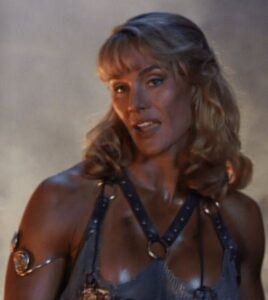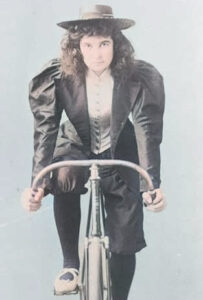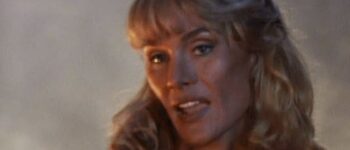1893: Atalanta’s Britches
October 26, 2023
By AHNZ

On 18 August 1892 the Atalanta Cycling Club was formed in Christchurch as the first all-women’s cycling club in Australasia. The cycling craze was on and there were many clubs but now young women were making it their own. The club’s first secretary was Anna Burn, aged 19. Club Captain Blanche Lough was 18 so we’re talking about an up-and-coming new generation¹.
According to Christchurch City Library’s blog it was Burns’ idea to call the new club Atlanta, “It was her idea that they take the name Atalanta, after the Greek heroine and huntress, and so in August 1892, the Atalanta Cycling Club was formed.”
Atlanta’s most famous depiction to date has been in the 1990s NZ-made TV show Hercules: The Legendary Journeys (image, left.)
A quick zip through New Zealand Wheelman magazine in the 1890s reveals that Atalanta Cycle Works (cr. Manchester and St. Asaph Streets) was a well-advertised business at that time. Their ‘Atalanta’ cycle appears prominent with male riders despite the feminine connotations of the name. It may be that the Atalanta was the bike of choice for the club or even that they were sponsored by the business.
Also, Algernon Swinburne’s popular anthology book about Atalanta, Atalanta in Calydon (1865,) would have been known to young New Zealand readers. Atalanta is depicted as a strong, independent, and courageous character. A skilled huntress, as well as a woman who challenges traditional gender roles and societal expectations. She dressed to suit her tasks in what 1890s culture would be called “Rational Dress.” Atalanta is an ancient symbol of female empowerment (and an example of a female lead in an action story long before Jennifer Lawrence in 2012.)
There was an economic explanation for this burst of New Women, especially in Christchurch. During the 1880s a labour shortage of women workers allowed those who remained to command high wages and above-normal working conditions. It appears to have helped artificially inflate the egos of the women of the colony so that they floated on a secure certain pillow of entitlement and privilege. To dismiss a women worker for being, for example, lippy or flippant or entitled, would leave a difficult position to fill. She, on the other hand, knows that another “dozen places are open to her.” Ref. Knox (1888.) This was the prelude to the Emancipated Women of the Rational Dress Movement, Feminism 1.0, and the Suffragettes.
“When some members of the club, including the club’s captain Blanche Lough, set off on a cycling excursion wearing knickerbockers, a practical garment promoted by dress reformers, the women had both verbal abuse and stones hurled at them. On the one hand, knickerbockers were seen as far too masculine and on the other, far too similar to women’s underwear.” – blog.tepapa.govt.nz (2018)
“Despite its popularity, and that of cycling generally, the Atalanta Cycling Club ceased to exist somewhere between November 1897 and October 1898.” – Clare Simpson (1993,) NZHistory.govt
Alice Burns “..moved to Edinburgh to study medicine. She took her four-year-old daughter with her and left her husband David behind to live his own life in New Zealand.” – Christchurch City Library’s blog (2023)
“…there was a great scarcity of house-servants in the colony, and he thought Christchurch was a little worse off than any other city,…those that can be obtained demand high wages, and are independent to a degree that would not be tolerated in England.” – Knox (1888)
“Childhood ends in life’s best-known rite of passage, the coming-of-age moment, what the Romans called adulescentia (literally, a “ripening” or “flaming up”). Many traditional societies ritualize this moment with a brief trial of pain, fear, or isolation, ceremonializing one’s death as a child and rebirth as an adult…The coming-of-age period is also when youths learn to substitute the approval of their friends for that of their parents—a substitution that helps forge a generational identity.” – The Fourth Turning, Neil Howe and William Strauss (2000)
“It was rather an unusual sight for so many lady cyclists to be seen wending their way round the hills…greeted by the Maories with a hearty cheer…On the return journey to Lyttleton the Chief Officer of the S.S. Gothic gave his consent for the club to go aboard and a pleasant half hour was spent. The party reached Christchurch at about 8pm..” – The New Zealand Wheelman, March 1894. Christchurch City Libraries

A key event for the Atalanta Cycling Club serves as a cultural barometer for New Zealand at that time. Leading up to 7 September, 1893, club attire had adopted the Rational Dress approach. Under the pretense of comfort or practicality, the women started cross-dressing in public. In particular, rather than a dress, they wore pants. It gave the impression that the women were wearing men’s clothing or, perhaps worse, cycling about in their underwear. 1893 was too soon and the public were outraged, sometimes violently, by the deliberate breaking of this taboo.
“As the Club has suffered no small degree from the report that all the members were in favour of the dress reform movement it was unanimously agreed that none of the members should be allowed to appear in that costume.” – ‘Cycling’, Star, 7 September 1893. blog.tepapa.govt.nz (2018)
So they had to back off. Yet, by 1896 female cyclists were appearing in pants in Christchurch. This means that during those 3 years our culture had taken a swing toward a broad line in sexual dimorphism. Ref. Woman cyclist in knickerbockers, Te Ara
Atalanta Cycling Club petered out by the end of 1898; The founders were now adults in their mid-20s and ready to move on. Cycling had served as a vehicle for this generation’s coming-of-age and they had nothing further to prove. A young generation frequently distinguishes itself by physical displays that are specifically exclusionary toward the elder generation. By taking up cycling young Atalantian Feminists stepped out of the shadow of older ones like Kate Sheppard and Anna Stout who could not physically compete with such marathon cycling tours. Young people can do things and wear things that mid-lifers simply cannot pull off and that’s a way of marking out who gets to be included and excluded from an identitarian group. For example, the Atalantians traveled from Christchurch to Governor’s Bay and back to the cheers of surprised “Maories” including an impromptu visit to a steamship; Home by 8pm.
 Apart from the 1896 mainstreaming of women in britches, observe the exaggerated masculine shoulder padding on the cyclist above! Women who wish to assert themselves artificially mimic male physical traits such as broadened shoulders. Desmond Morris quotes a fashion historian, “‘The slightly puffed shoulders developed into epaulettes and then into something looking like small bags until by 1895 they were rather like a pair of large balloons quivering on the shoulders.’ These broad-shouldered women competed with men by taking university degrees, going out to work and engaging in sports that hitherto had been barred to them.” Ref. p131 Body Watching, Morris (1985)
Apart from the 1896 mainstreaming of women in britches, observe the exaggerated masculine shoulder padding on the cyclist above! Women who wish to assert themselves artificially mimic male physical traits such as broadened shoulders. Desmond Morris quotes a fashion historian, “‘The slightly puffed shoulders developed into epaulettes and then into something looking like small bags until by 1895 they were rather like a pair of large balloons quivering on the shoulders.’ These broad-shouldered women competed with men by taking university degrees, going out to work and engaging in sports that hitherto had been barred to them.” Ref. p131 Body Watching, Morris (1985)
In the late 1890s a crisis point was reached. The doorways of the colony simply were not wide enough for shoulders to burst any wider!
Here might be found a social-sexual reason for why New Zealand men eagerly rushed off to Second Boer War. Going away with weapons to fight something, per chance to die, can be a man’s version of augmented masculinity. Ref. 1899: Boer War, AHNZ
Rather than restore normal gender relations by going to war the men only upped the ante. Back home, our women dressed even more like men and started donning military uniforms and practicing arms drill! 1900: The Khaki Girls, AHNZ
‘Secretary’ Anna Burn’s radical r-selected youth behind her at last, she took a leaf out of her senior’s book. Like Kate Sheppard before he, she walked out on her husband and started a different life.
William Pember Reeves (b.1857) and Michael Joseph Savage (b.1872) were part of the same generation: the Vogel Boomers. Both hard-lefties, there were always questions about their fidelity too. Ref. 1936: Savage’s Unconventional Family, AHNZ
‘Captain’ Blanche Lough married and became a jet-setter, travelling around the world. The couple were apparently tied up with Alexander Bickerton’s Socialist Commune experiment.
The entire period described is what history cycle writers Neil Howe and William Strauss called a Third Turning. New Zealand was Unraveling and it’s always the r-selected Lefties pulling at the threads. It came to Crisis (Fourth Turning) with the Great War in 1914. Only after that did New Zealand start having firm and secure ideas about identity, male and female alike. But, you know, these Unraveling periods keep coming back. By the 2020s we started talking about “what is a woman,” crafting complex “gender pronouns,” referring to “partners” instead of husbands, “birthing person” instead of mother, “people who get periods” instead of woman,…
—
1 Atalanta Cycling Club, NZHistory.govt
Image ref. Cory Everson as Atalanta in Hercules: The Legendary Journeys (1995)
Image ref. Cyclist girl in 1896, top half. Attributed to Christchurch City Libraries. Colourised by AHNZ
Image ref. Euphemia Newbiggen Richardson’s enormous shoulders. Tyree Studio Collection, Nelson Provincial Museum
Ref. Boy Travellers in Australasia, Thomas Knox (1888)
Ref. 1906: Side-Saddle Aside, AHNZ
 Like Comment Share
Like Comment Share





